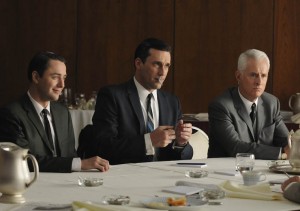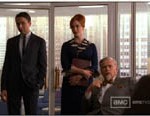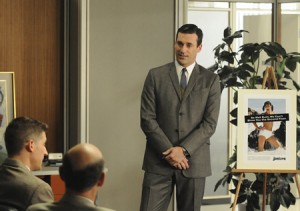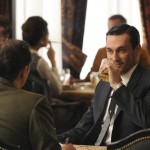(Article first published as Starting An Ad Agency the Mad Men Way on Blogcritics.)
Don Draper, Creative Director, Steps Out Front And Center
 Season four of Mad Men is off to a great start with the birth of a new Ad Agency. Episode 1, “Public Relations” provides a glimpse into some of the challenges and drama that were part of starting these new ventures in the Mad Men era. In looking at the show I have to remind myself that Mad Men is not a documentary about advertising in the ‘60’s. It is, however, a wonderful period piece soap opera that brilliantly captures the essence and psyche of the advertising business back then. Mad Men is TV at its best so there is an expected degree of exaggeration, hyperbole and caricature. While some of the situations depicted are a bit over the top, overall Mad Men captures the reality and raw emotions of the business that resonate with me. Here’s a look behind the scenes that will add some texture and context to what the folks at the new Sterling, Cooper, Draper & Pryce are going through. For more information about advertising click here.
Season four of Mad Men is off to a great start with the birth of a new Ad Agency. Episode 1, “Public Relations” provides a glimpse into some of the challenges and drama that were part of starting these new ventures in the Mad Men era. In looking at the show I have to remind myself that Mad Men is not a documentary about advertising in the ‘60’s. It is, however, a wonderful period piece soap opera that brilliantly captures the essence and psyche of the advertising business back then. Mad Men is TV at its best so there is an expected degree of exaggeration, hyperbole and caricature. While some of the situations depicted are a bit over the top, overall Mad Men captures the reality and raw emotions of the business that resonate with me. Here’s a look behind the scenes that will add some texture and context to what the folks at the new Sterling, Cooper, Draper & Pryce are going through. For more information about advertising click here.
Fire Us! Please
When Mad Men closed out Season 3, the key principals of Sterling Cooper decided to, pick up, pack it up and set up a new agency. Admittedly, the reality of such a move wasn’t as simple as Mad Men portrayed it….an abrupt walk out of the key players, moving a client on the spot, and an overnight clean out of all the files. It took a lot more maneuvering, carefully choreographed discussions, managing 90 day client termination agreements, negotiating employment contract exits, etc. But, this definitely was the time for a liberated generation of Mad Men to rise up and shine, flex their creative muscles, and boldly declare their independence. The cult and culture of the creative personality emerged with a new look and a powerful passion.
Season 4’s first episode captured the dynamics of this culture shift when it opened with Don’s botched interview with an Advertising Age reporter and closed with Don’s assertive Wall Street Journal redemption. (On the subject of the Ad Age interview, Rance Crain, one of the great business journalists and long time editor-in-chief of Ad Age wrote a nice piece on how these types of interviews were really conducted.)
Names On The Door: “Who is Don Draper?”
Advertising agencies in some part modeled themselves after other service businesses like accounting and law firms. So, having the company name embrace and identify the principals was nothing new. From some of the oldest names in the ad business (McCann-Erickson N. W. Ayer & Son, Batten, Barton, Durstine & Osborne, Leo Burnett, Young & Rubicam) to some of the newcomers of the 1950’s (Doyle Dane Bernbach, Ogilvy, Benson & Mather ) names on the door helped create an feeling of personal attention and responsibility. Then, in the late “50’s and early ‘60’s creative geniuses like Bill Bernbach and David Ogilvy lit a new spark of creativity with breakthrough campaigns for Volkswagen, Alka-Seltzer, Hathaway, Schweepes and others. Suddenly, clients and industry executives were more interested in the people behind the ads than the company names in front of them. Energized by this new attitude and bolstered by the fact that advertising was (and still is) a low cost of entry business (a vision, ideas, “pads&pencils”, confidence and salesmanship) many of the creative people behind those campaigns decided to strike out on their own…. and they did so in record numbers.
Most often it was the creative principal who was the face, voice and soul of the new company….a huge responsibility. So, in this episode when  Don took a “modest’, low profile approach to the agency’s big PR shot and the Advertising Age article described Don Draper as a “handsome cipher,” it got everyone pissed off. It prompted Roger Sterling to complain, “You turned all the sizzle from Glo-Coat into a wet fart.”. Bert Cooper put it a bit more diplomatically when he said “Turning creative success into business is your work, and you’ve failed.” When your name is on the door you have to make it matter.
Don took a “modest’, low profile approach to the agency’s big PR shot and the Advertising Age article described Don Draper as a “handsome cipher,” it got everyone pissed off. It prompted Roger Sterling to complain, “You turned all the sizzle from Glo-Coat into a wet fart.”. Bert Cooper put it a bit more diplomatically when he said “Turning creative success into business is your work, and you’ve failed.” When your name is on the door you have to make it matter.
High Risk. High Reward. Even Higher Tensions
The 1960’s spawned a wonderful new breed of Mad Men. These were brilliant creative people with the talent, passion and “balls” to trade on their creative reputations and start a business with nothing, or perhaps the “promise” of an account or at best one client. They inspired a cadre of trusted talent to take the plunge with them and launched creative boutiques that kicked the creative revolution in advertising into high gear. Some set up shop in hotel suites, others camped out in borrowed office space and some found enough money to rent space. They gave up the trappings, staff, space and security of established companies for a much leaner, meaner business environment in which they could flex their creative muscles and do great work. The stakes were high, the energy even higher and the potential for fame and fortune or failure was equally present and lurking around the corner every day. These new business were fragile and the loss of one account could shutter the agency. The pressure to do whatever it took to attract and keep clients was sometimes in conflict the creative leader’s desire to stand up for his or her creative principles.
 That natural tension showed up in this episode during the agency’s pitch for the Janzten swimwear account. Don refused to compromise on the creative approach, unceremoniously asked the clients to leave and decided then and there that it would be his voice and his creative vision that would lead the company. In the final scene, the Wall Street Journal reporter leads with this question. “There is always a name in every agency partnership who defines who they are. In the case of Sterling Cooper Draper Pryce would you say that is Don Draper.?” Don’s answer…an emphatic Yes! Just like the great real world creative agencies, the new Mad Men agency will be defined by its creative leader…Don Draper. It will be interesting to see how this plays out in future episodes.
That natural tension showed up in this episode during the agency’s pitch for the Janzten swimwear account. Don refused to compromise on the creative approach, unceremoniously asked the clients to leave and decided then and there that it would be his voice and his creative vision that would lead the company. In the final scene, the Wall Street Journal reporter leads with this question. “There is always a name in every agency partnership who defines who they are. In the case of Sterling Cooper Draper Pryce would you say that is Don Draper.?” Don’s answer…an emphatic Yes! Just like the great real world creative agencies, the new Mad Men agency will be defined by its creative leader…Don Draper. It will be interesting to see how this plays out in future episodes.
Who Were Some Of These Mad Men?
Most of these bold new creative leaders of the sixties grew up under Bill Bernbach, David Ogilvy, Leo Burnett and others. Even, McCann-Erickson, one of the oldest established agencies, got into the act when they spun off an elite, creative think tank, Jack Tinker & Partners in 1964. Some of the real Mad Men of the ‘60’s who lead the way and inspired my generation were George Lois, Shep Kurnit, Jerry Della Femina, Mary Wells, Leo Greenland. They started what Jerry Della Femina called the “swinging agencies”…..Wells, Rich, Greene; Delehanty, Kurnit & Geller; Smith/Greenland; Daniel & Charles to name a few.
After my initial stint at Benton & Bowles from 1965 -1970 I was lucky enough to spend my next 10 years working with some of the best creative stars that emerged from this era. First at Doyle Dane Bernbach working with Dave Ryder, Bill Taubin, Bob Levinson, Roy Grace and Evan Stark. Then as a partner at Delehanty Kurnit & Geller (later named DKG) where Shep Kurnit and Neil Calet took me under their wings and we were named Agency of The Year by Ad Age in the mid ‘70’s.
 Finally, here’s an interesting coincidence. In the last scene of this episode with the WSJ reporter, Don abandons modesty and says, “Last year, our agency was being swallowed whole and I could die of boredom or holster up my guns. So I walked into Lane Pryce’s office and I said, ‘Fire us.’ Within a year, we’d taken over two floors of the Time-Life Building.” Our offices at DKG were on the 38th floor of the Time Life Building. Go figure. I spent 7 years at DKG and never ran into Don in the elevator.
Finally, here’s an interesting coincidence. In the last scene of this episode with the WSJ reporter, Don abandons modesty and says, “Last year, our agency was being swallowed whole and I could die of boredom or holster up my guns. So I walked into Lane Pryce’s office and I said, ‘Fire us.’ Within a year, we’d taken over two floors of the Time-Life Building.” Our offices at DKG were on the 38th floor of the Time Life Building. Go figure. I spent 7 years at DKG and never ran into Don in the elevator.
Stay Tuned.
